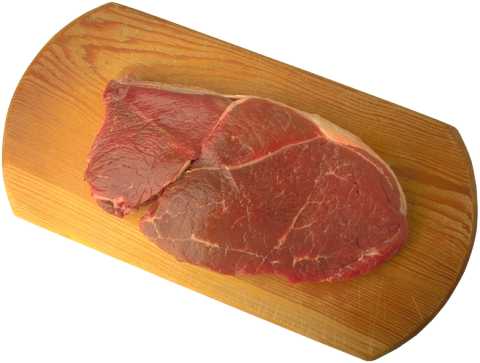Q: What's the difference among the USDA grades of beef? Which is better, Choice or Select? Where does Angus beef fit into this scheme?
A: The United States Department of Agriculture grades beef according to an eight-grade system. It is not required by law; the packing house decides whether to grade it beef or not. The grade is on the entire carcass, not on just the big primal cuts the supermarket butchers handle. The main criterion is how much fat occurs in the lean parts of the beef, a quality that shows up as fat "marbling" in the lean. The more fat, the better.
[caption id="attachment_42773" align="alignnone" width="480"] A not-very-well marbled round steak. I'd guess the USDA grade is Select.[/caption]
The top grade is USDA Prime, the overwhelming majority of which goes to restaurants--although some specialty butchers carry Prime. Next is Choice, which is the most common grade in all but discounted markets. Select is below Choice. I wouldn't get that for sirloin strip steaks or brisket, but Select filets and ribeyes are acceptable.
Below that are five more USDA grades, none of which you are likely to see in any meat market. The names alone tell you they aren't desirable: Standard, Commercial, Utility, Cutter and Canner. (I have long campaigned to have Standard renamed "USDA Okie-Dokey.") Beef that would grade below Select but headed for a retail meat counter is usually not graded at all. Such beef is known in the trade as "no-roll," a reference to the rolling, purple-ink marker that identifies USDA grading. I'll just say this: you probably eat more no-roll beef than any other grade. Especially if you shop for price.)
"Angus" is a breed of cattle, not a grade. It has no direct relationship to the USDA grading system, although Black Angus beef tends to grade higher than most other breeds. "Certified Angus Beef" and similar identifiers are trademarks used by a group of cattlemen to identify beef that meets the group's own standards, which are more stringent than the USDA standards. (Certified Angus Beef is, for example, from younger cows raised in the Midwest and Plains states.)
Here's a funny thing: there is no comparable grading system for pork or lamb.
A not-very-well marbled round steak. I'd guess the USDA grade is Select.[/caption]
The top grade is USDA Prime, the overwhelming majority of which goes to restaurants--although some specialty butchers carry Prime. Next is Choice, which is the most common grade in all but discounted markets. Select is below Choice. I wouldn't get that for sirloin strip steaks or brisket, but Select filets and ribeyes are acceptable.
Below that are five more USDA grades, none of which you are likely to see in any meat market. The names alone tell you they aren't desirable: Standard, Commercial, Utility, Cutter and Canner. (I have long campaigned to have Standard renamed "USDA Okie-Dokey.") Beef that would grade below Select but headed for a retail meat counter is usually not graded at all. Such beef is known in the trade as "no-roll," a reference to the rolling, purple-ink marker that identifies USDA grading. I'll just say this: you probably eat more no-roll beef than any other grade. Especially if you shop for price.)
"Angus" is a breed of cattle, not a grade. It has no direct relationship to the USDA grading system, although Black Angus beef tends to grade higher than most other breeds. "Certified Angus Beef" and similar identifiers are trademarks used by a group of cattlemen to identify beef that meets the group's own standards, which are more stringent than the USDA standards. (Certified Angus Beef is, for example, from younger cows raised in the Midwest and Plains states.)
Here's a funny thing: there is no comparable grading system for pork or lamb.
